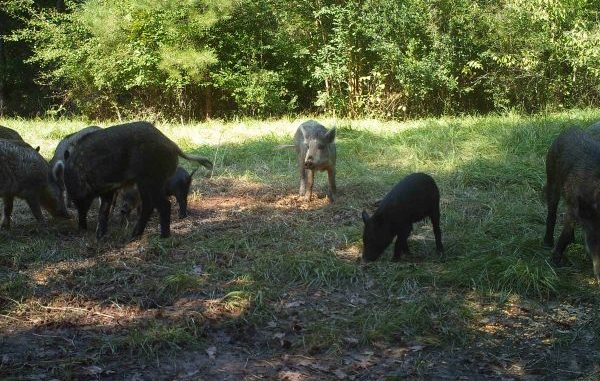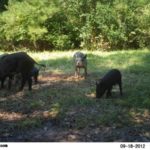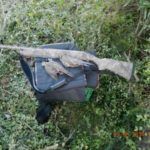
Biologists meet to develop a response to feral hog invasion
Last month in this column I paid tribute to the wild hog, which has been in this country for 500 years. My point was that this critter has been able to survive despite the fact that most are out to eliminate it from the landscape.
While the feral hog is certainly a serious problem, I find it to be a very challenging wild animal to hunt. It is an intelligent animal, and that is probably the reason it has survived for so long.
The Louisiana Association of Professional Biologists and the Wildlife Society Louisiana Chapter met recently in Baton Rouge to weigh in on the issue of feral hogs in Louisiana.
The feral hog’s range has greatly increased in the state, and hogs are creating problems for farmers, foresters and landowners in general — and this was the focus of these biologists.
This organization consists of university scientists and researchers, wildlife biologists, fish biologists and environmental biologists, as well as students pursuing a career in wildlife.
Many of the biologists work for governmental agencies, while some work independently with landowners.
All of the universities in the state are represented by the organization.
The only drawback is that they allow membership by old, retired farts like myself — simple-minded old-school biologists, who are not up to date with the modern technology utilized by biologists today.
It was pretty clear from the symposium that Louisiana has a feral hog problem and something needs to be done.
Kim Tolson from ULM made a presentation concerning pig reproduction in the state. This was a project she and LDWF wildlife vet Jim Lacour conducted in which they studied the reproductive potential of feral hogs and found it similar to other wild pig populations in the South.
Gestation period is 114 days, sows ovulate at a young age (less than 1 year old) and adult sows can have two litters a year, with an average of five to six piglets per litter if conditions are right.
I killed a sow one time that had nine fetuses; the number of fetuses in this study ranged from one to 10.
The fact that feral hogs can produce more young than white-tailed deer is a problem for deer hunters and managers because pigs compete with resident game animals for food, especially the mast crop.
Research has shown that deer tend to avoid sites frequented by pigs, which also presents problems for hunters. Hunters who feed deer corn will be feeding hogs more than the deer if there are pigs in the area.
LDWF reported again that more hogs than deer were killed during the 2013 deer season.
While there was not much discussion regarding pigs and disease, this is an issue that can affect deer populations, as well as humans, and is a cause for concern.
However, if hog meat is cooked properly it can be eaten, and I must confess that I have eaten hogs killed on our property that tested positive for disease.
The main issue is with the processing of the hogs, and exposing oneself to blood and other hog fluid contamination. Always wear gloves, don’t eat or drink anything when cleaning hogs, and keep your cleaning gear washed and sterilized.
A presentation by LDWF’s Todd Baker showed marshland can be restored by the removal of hogs from the landscape.
There was another presentation by Glenn Gentry with the LSU Ag Center concerning use of sodium nitrite as a poison for feral hogs. No doubt you have read about the idea of poisoning hogs. The issue here is to get something that targets only hogs and causes no harm to other animals and humans.
Another presentation concerned movement of feral hogs; the results of this work indicated natural movements of hogs is not the reason for this broad-scale range expansion in the state.
So why have hog numbers dramatically increased around the state?
The primary reason for the increase is that hogs are being caught and transported from one area of the state to another. In the past, some hunters and landowners who did not have hogs on their property did this with the idea of having another animal to hunt.
It sounds like a good idea to put another animal on the landscape to hunt, but it has backfired big time.
Today, hogs are still being moved around, despite the fact that their numbers are already high. LDWF is very much opposed to this practice for obvious reason.
Farmers certainly do not want hogs on land one which they are trying to grow crops, and forest landowners do not need hogs in the woods rooting up the landscape.
Those attending the symposium pretty much were in agreement that this needs to stop. It could be something prohibited by legislation, but it appears the Ag Department is not interested in this. Like deer, feral hogs have become a business activity, and anytime this happens it becomes difficult to control or restrict.
While I enjoy hunting hogs, I am not in favor of this activity that moves hogs around the state. The hog population on our property appears down this year, and the hog hunting has been very slow — but I would never consider having hogs brought in.
The mast crop failure last year probably contributed to our low numbers, and no doubt — with the reproductive potential of pigs — our numbers will increase over time.
First shots of the season
The opening split of the dove season has come and gone. I participated in the first-ever hunt at daylight on our small property.
While there were not many birds in the bag, I enjoyed the early morning hunt. I also learned more about the wildlife on our property.
I watched our numerous bluebirds feeding on insects, along with a whole lot of yellow-billed cuckoos (that look a lot like doves when they fly), during the hunt.
I knew we had a good bluebird population, but was not aware that we had so many cuckoos! My dad called them rain-crows. It is a neat bird, and if you are not familiar with it, just Google it and let technology enlighten you.
I did make another dove hunt with my friend Rick Meador and killed a dozen doves for the grill. This year, I had planted sunflowers, sorghum and purple hull peas; the heavy rain we had during the summer hammered the sunflowers, but the peas did quite well and the pea pickin’ was great. I think next year I will plant brown top millet and sunflowers.
In early August, I planted two new patches of purple hull peas, with the idea of having some October pea patches for deer hunting.
I had planted American jointvetch in early summer, and these strips did great and deer are feeding in them every day.
It looked like the deer were going to stay in the vetch and I was going to do some more pea pickin’ in October, but by the third week of September the deer started eating peas and there will be no peas to pick — and I probably will not be doing any hunting on the patches, either.
Oh well: It will be easy to convert these to winter patches for the lates-season hunts.
By now, the harvest of deer is under way, and perhaps you have been blessed to kill one.
Be sure to check out the Hunters for the Hungry Program and share a deer with those who have needs.




